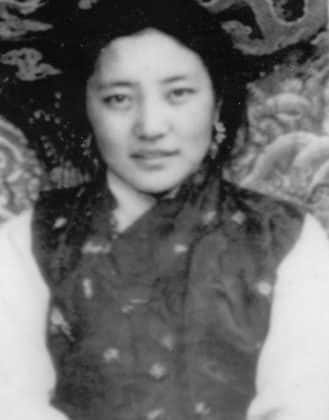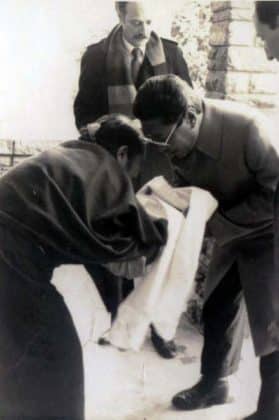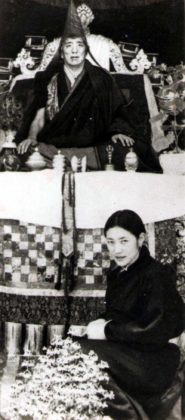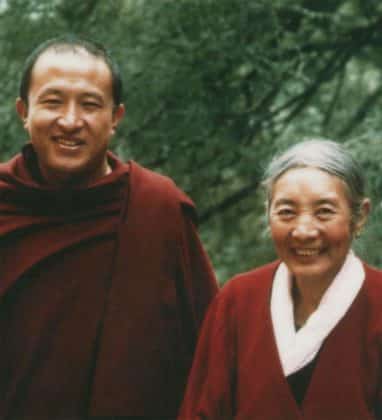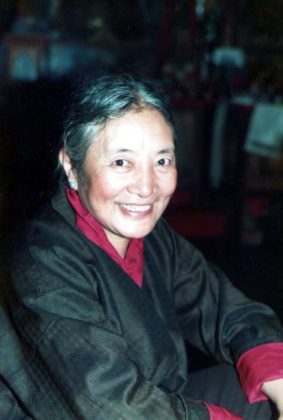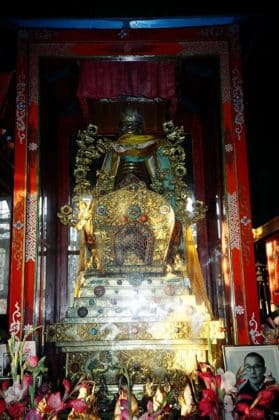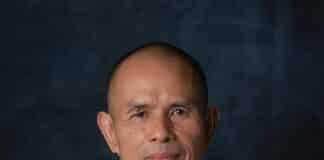By Clarke Warren
I have just received news of the parinirvana of Khandro Tsering. Khandro Tsering was the wife/spiritual consort of the great Jamyang Khyentse Chokyi Lodro Rinpoche, the rebirth of Jamyang Khyentse Wangpo the Great. Jamyang Khyentse the Great was a great spiritual teacher and scholar, a founder of the non-sectarian Ri-me movement in Tibet, and one of the greatest tertons (discoverer of hidden spiritual treasure of Guru Padmasambhava). His rebirth, Chokyi Lodro Rinpoche, Khandro Tsering’s husband, was likewise great, and was the teacher of both Dilgo Khyentse Rinpoche and Chögyam Trungpa Rinpoche, and virtually an entire generation of great lamas and practitioners. You can see his photo and read about him in Trungpa Rinpoche’s Born in Tibet. Khandro Tsering has likewise been chronicled and extolled in the writings and publications of Sogyal Rinpoche, who is also her nephew.
The passing of Khandro Tsering, the wife of the great Jamyang Khyentse Chokyi Lodro, is a major milestone in the sacred history of Tibetan Buddhism and the Buddhadharma as a whole. Khandro Tsering was utterly unassuming, the very imprint of selflessness and humility, and simultaneously one of the great expressions of enlightenment in our time. Though she would, I have no doubt, incisively deny this.
Khandro Tsering, as the wife of one of the great tertons of recent times, is as significant and instrumental to the vast and profound lineage of which Chögyam Trungpa Rinpoche is a brilliant manifestation, as was her husband. In the terma (hidden spiritual treasure) tradition, the terton (treasure discoverer) is an incarnation of one of Padmasambhava’s original students, who was entrusted to uncover the spiritual treasure at a time when it would be of most benefit to beings. The presence of the terton’s spiritual consort is essential to the discovery and propagation of the terma. Not only that, but it is said the consort was also present with the terton and Padmasambhava, at the time when the treasure was entrusted to the future terton. Their reunion in future rebirths, and their mutual presence at the propitious time and place for uncovering the terma, is essential. Such is the character of Khandro Tsering!
Having met Khandro-la during her one visit to the USA many years ago, I was thrilled to be her neighbor during the five years I directed the Naropa University study abroad program in Sikkim. Sikkim was, until its incorporation into India as a state in 1975, a Vajrayana Buddhist kingdom, and a “hidden land” of great spiritual potency, sanctified by Padmasambhava/Guru Rinpoche, who also predicted all the circumstances which led to the discovery and establishment of the Buddhist Kingdom, centuries later. The entire kingdom is a sacred power place, and has for centuries been a highly potent place to practice and attain realization. As Jamyang Khyentse Chokyi Lodro and Khandro Tsering are considered the direct emissaries of Guru Rinpoche, it was highly appropriate that they came to live in Sikkim upon their escape from Tibet. For me, moving to Sikkim many years later and becoming a neighbor of Khandro Tsering was like moving into the neighborhood of Yeshe Tsogyal, Guru Rinpoche’s spiritual consort, though I am certain that Khandro Tsering would have sharply disagreed!
I will always treasure being so close to her in Sikkim. I saw her almost every day on the way from my cottage to morning sitting with the Naropa students. I would see her thin form in an intent pace on her morning circumambulation around the hill which was crowned with the palace of the Dharma King (Chogyal) of Sikkim, where she lived. As I approached her, I would slow my motorcycle to a crawl, to bow to her as I passed her. She always threw her arms straight up in the air in response, like a referee signaling a touchdown.
She also would occasionally stop by the Hotel Pomra (where the Naropa program was housed, just down the road from the palace), as she was good friends with Ringu Tulku Rinpoche’s mother. (Ringu Tulku Rinpoche and his family owned and lived on the upper floors of Hotel Pomra). She would sometimes peek curiously through the door to the dining room, to watch us eating breakfast, for a few moments.
I also remember stories about her, such as her being, in reality, a Queen of the Nagas. Nagas are the powerful embodiment of the elemental force of water; they are said to be half human, half serpent, and keepers of great treasure. One local woman had peeked into Khandro-la’s window once, and reported being quite shocked to see that the bottom half of her body was serpent coils.
Naga queen or not, she was an amazing woman. She was utterly humble and unassuming, yet immensely warm, spacious and open, yet simultaneously sharp as a cosmic razor. You couldn’t put your finger on anything, the experience was utterly simple and ordinary, but your awareness was transformed in her presence.
I remember the last time she was to be in Sikkim, after all the years she had stayed there after their arrival from Tibet, and since the Parinirvana of her husband, Jamyang Khyentse Chokyi Lodro, in 1959. She lived in a large drafty room, behind the main shrine hall, which contained the Kudung (the body relics) stupa of her husband. Ringu Tulku Rinpoche, who had known her since he was a child, said she never, over the years, changed a thing in the hall. She stayed there and practiced constantly, for years and years. When I visited her, I would attempt to prostrate to her. She would stop me, and insist I prostrate to the stupa of her husband, not her. Once she actually grabbed my arm and turned me toward the stupa. Asking her questions never went very far. After a while, I would simply ask to sit and practice with her for a few minutes, and to circumambulate the stupa. Any attempt to treat her as anything special at all would meet with cordial but definite rebuff. She would offer a tin of candies and nuts.
The image of her practicing in her room is indelible in my memory. A somewhat frail, yet immensely strong and pronounced presence, she sat alone on her bed, which was also her meditation seat, fingering her mala before the stupa of her husband. I think, though, that my impression was naive if I regarded her as an isolated yogini in semi-retreat. I think she was continually performing great benefit for sentient beings, on a level far beyond my perception.
When she started to get sick, one of my American staff took her some chicken soup, thinking she wasn’t getting proper nutrition. I later heard she abruptly sent the soup away with her attendant, as soon as the person left, not being interested at all in the strange foreign concoction!
Khandro Tsering came to the West once, at the behest of her nephew, Sogyal Rinpoche. She visited Boulder, and her entire Dharma activity was to simply have people sit silently with her at Marpa House where she stayed. She refused to teach in the conventional verbal sense of the word. We heard that her husband, Jamyang Khyentse Chokyi Lodro Rinpoche, had instructed her to do this, and that in this way she would be of great benefit. Of course, simply sitting with her was profound. It was the most direct instruction possible. Before departing, she presented some relics of Chokyi Lodro to the Boulder Vajradhatu sangha, which sat on the Vajrayana shrine at Marpa House for many years. I don’t know if they are still there, or if not, what has happened to them. They are a great treasure given to us from Khandro-la.
Dzongsar Khyentse Rinpoche, the rebirth of her husband, arrived in Gangtok one day, out of the blue and unannounced. Once the presence of such a great lama was detected, the newspaper reported he was performing long life ceremonies for her. The next day, we learned that in fact he was there to take her away, as he had come to know that her health was waning. The next day, she was gone, before anyone but the very few knew what had happened, like the imprint of a bird in the sky. Sikkim had lost a great treasure. She was taken for medical treatment to Delhi, then to Dzongsar Khyentse Rinpoche’s seat in Bir, India.
During my five years in Sikkim, I had the privilege of getting to know two great dakinis/khandros. It was like being neighbors with both Yeshe Tsogyal and Mandarava, the two consorts of Guru Rinpoche! One was, of course. Khandro Tsering. The other was the Khandro Dechen Pema, the khandro of Dodrupchen Rinpoche, who passed away while I was still there. Sitting with Khandro Dechen Pema’s body was an immensely profound experience. I only wish I could sit with Khandro Tsering’s kudung right now.
May Khandro Tsering’s Buddha activity return to our world for the benefit of countless beings!
Clarke Warren
June 1, 2011




